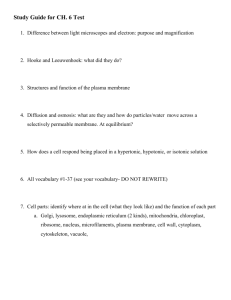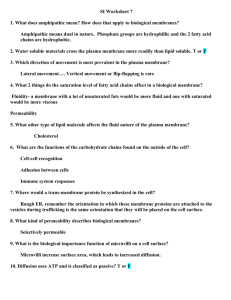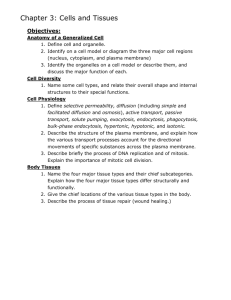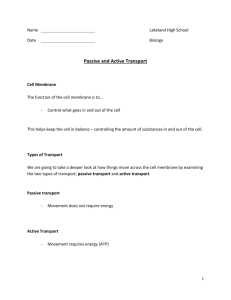Unit 1 Learning Outcomes
advertisement
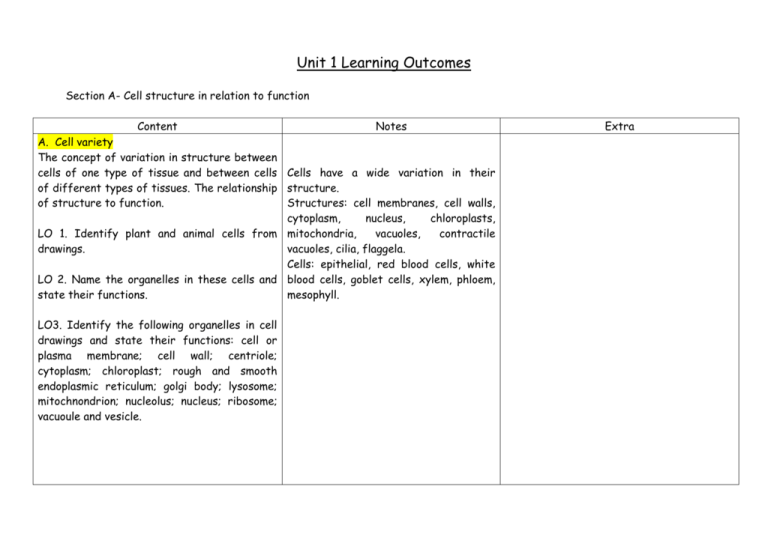
Unit 1 Learning Outcomes Section A- Cell structure in relation to function Content Notes A. Cell variety The concept of variation in structure between cells of one type of tissue and between cells Cells have a wide variation in their of different types of tissues. The relationship structure. of structure to function. Structures: cell membranes, cell walls, cytoplasm, nucleus, chloroplasts, LO 1. Identify plant and animal cells from mitochondria, vacuoles, contractile drawings. vacuoles, cilia, flaggela. Cells: epithelial, red blood cells, white LO 2. Name the organelles in these cells and blood cells, goblet cells, xylem, phloem, state their functions. mesophyll. LO3. Identify the following organelles in cell drawings and state their functions: cell or plasma membrane; cell wall; centriole; cytoplasm; chloroplast; rough and smooth endoplasmic reticulum; golgi body; lysosome; mitochnondrion; nucleolus; nucleus; ribosome; vacuoule and vesicle. Extra LO 4. Identify and explain the variations in the structure of the cells in the following tissues: i) blood- red blood cells, white blood cells; ii) epithelium- glandular, ciliated and columnar; iii) mesophyll- palisade and spongy iv) transport tissues- cylem and phloem. LO 5. The existence of unicellular organisms. Some cells are complete organisms. These cells must be able to perform all life functions. LO 6. Explain the relationship between cells, Cells in multicellular organisms are tissues, organs, systems and organisms in specialised for a single function and rely multicellular organisms. on a variety of cells in other tissues to perform all the other life functionsknown as “Division Of Labour”. Specialised structure of a cell depends on the particular function that it performs. Examples of specialised cells: Sperm cells are specialised for swimming so their structure includes a tail and they contain lots of mitochondria for energy. Palisade mesophyll cells that are tightly packed and contain many chloroplasts for photosynthesis. B. Cell wall: reference to cellulose fibres and permeability. Cell walls in plant cells composed mailnly of cellulose fibres in a criss-cross LO 7. Describe the structure of the plant cell pattern. wall and explain how it is involved in the Cellulose is a tough fibrous material, movement of water through plant tissues. classed as a structural carbohydrate. The fibres give the cell support. Cell walls are freely permeable. C. Plasma membrane: reference to fluid mosaic model. The plasma membrane is referred to as a ‘fluid mosaic’. LO 8. Describe the structure of the plasma It is made of a bi-layer of phospholipids membrane using the fluid mosaic model. with embedded protein molecules. The phospholipids have a hydrophilic (water liking) head and a hydrophobic (water hating) tail. This means that when placed in water they arrange themselves with the heads in the water and the tails grouped together. Some of the proteins that are embedded in the plasma membrane have channels that can transport some substances rapidly through the membrane but can prevent other substances from passing through. This structure allows membranes to be selectively permeable and to change shape easily and quickly. D. Absorption and secretion of materials. Diffusion and osmosis as basic cell processes. The role of the cell wall and plasma membrane in relation to these processes. Diffusion is the movement of molecules from an area of high concentration to an LO 9. Explain the movement of materials into area of low concentration. Osmosis is a and out of cells by diffusion, osmosis, active special case of diffusion involving the transport, phagocytosis and pinocytosis. movement of water molecules. LO 10. Define the term water potential and Osmosis occurs because water diffuses make use of this concept to describe water through the plasma membrane quicker movement into, out of and between cells. than most dissolved substances. LO 11. Correctly use the following terms: ‘High water concentration’ means a selectively permeable membrane; solution with lots of water and little concentration gradient; turgid; flaccid; solute. Pure water has the highest water plasmolysed; hypertonic; hypotonic and concentration. isotonic. ‘Low water concentration’ means a solution with lots of solute dissolved in it. Hypertonic solutions have less water and more solute than the solution they are compared to. Hypotonic solutions have more water and less solute than the solution they are compared to. Isotonic solutions have equal water LO 12. Predict what will happen to animal and concentrations. plant cells when they are placed in solutions of different solute concentrations. Animal cells will burst if placed in hypotonic solutions and shrink in hypertonic solutions. Plant cells become turgid in hypotonic solutions and become plasmolysed in hypertonic solutions. E. Function of plasma membrane in relation to Plant tissues become flaccid if placed in selective ion uptake (active transport) and hypertonic solutions. absorption and release of chemicals. Molecules that cross the membrane by diffusion move down a concentration gradient, requiring no energy. LO 13. State the conditions under which active Some substances can be forced through transport will occur best. a membrane against a concentration gradient. This requires a supply of energy. This process is called Active Transport.

